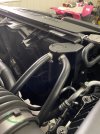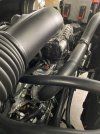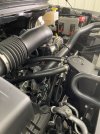1/2" should be rightAnyone know what size tubing they used to connect to and from the can?
I have some 1/2 inch tubing but I think it's too small for the fittings.
5thGenRams Forums
You are using an out of date browser. It may not display this or other websites correctly.
You should upgrade or use an alternative browser.
You should upgrade or use an alternative browser.
What's with the oil catch cans?
- Thread starter ChrisW74
- Start date
Darksteel165
Legendary member
Plan on taking a swing at installing my can tomorrow after all pads and oil on my wife's Acadia. Guess ill find out then, it didn't look like what I had would fit, i'm used to using barb fittings and it looks like this needs clamps.1/2" should be right
The Mishimoto I bought came with hoses and clamps. Which catch can do you have?Plan on taking a swing at installing my can tomorrow after all pads and oil on my wife's Acadia. Guess ill find out then, it didn't look like what I had would fit, i'm used to using barb fittings and it looks like this needs clamps.
Darksteel165
Legendary member
I have a Team RXP catch can(s).The Mishimoto I bought came with hoses and clamps. Which catch can do you have?
Was going to take a swing at it but after doing front and rear brake pads + oil change on the wife's Acadia, I ran willpower when I went to look at the oil filter location on the Ram as I was going to do a quick change before trying to add the can...
MO Rebel
Well-Known Member
The Mishimoto I bought came with hoses and clamps. Which catch can do you have?
You ever had any issues with the clamps not securing tight enough to keep it from seeping out? I had that issue on my 2013 F-150 until I heat sealed some Ford snap connectors to the hoses.
Nope, no issues with that.You ever had any issues with the clamps not securing tight enough to keep it from seeping out? I had that issue on my 2013 F-150 until I heat sealed some Ford snap connectors to the hoses.
Darksteel165
Legendary member
Sounds like you have bad clamps or fittings.You ever had any issues with the clamps not securing tight enough to keep it from seeping out? I had that issue on my 2013 F-150 until I heat sealed some Ford snap connectors to the hoses.
MO Rebel
Well-Known Member
Twin turbo pushes a lot more pressure. I didn’t want to cinch them down too tight and crack the plastic barbs. Once I put the Ford snap connectors on, I didn’t have any more issues.Sounds like you have bad clamps or fittings.
MO Rebel
Well-Known Member
TheWaterman83
Well-Known Member
- Joined
- Dec 31, 2021
- Messages
- 431
- Reaction score
- 396
- Points
- 63
- Age
- 42
Late to the party on this but...are these worth installing at about 48K in miles or has that ship already sailed?
Kind of like quitting smoking...it's never too late.Late to the party on this but...are these worth installing at about 48K in miles or has that ship already sailed?
Rlaf75
Takes potshots
- Joined
- Jul 9, 2021
- Messages
- 1,686
- Reaction score
- 2,152
- Points
- 113
- Age
- 50
Anthing to keep that unwanted oil from burning in the combustion chamber is better than nothing. I don't know if it's the placebo effect but I added a catch can and removed the carbon filter from the stock air box several months ago and it seems like the truck gained a mile or two per gallon. There is definitely no added power felt
TheWaterman83
Well-Known Member
- Joined
- Dec 31, 2021
- Messages
- 431
- Reaction score
- 396
- Points
- 63
- Age
- 42
We run "oil rebreathers" on our marine diesels and the amount of "catch" is astounding. Now, granted, those motors hold close to 30 quarts of oil each.Anthing to keep that unwanted oil from burning in the combustion chamber is better than nothing. I don't know if it's the placebo effect but I added a catch can and removed the carbon filter from the stock air box several months ago and it seems like the truck gained a mile or two per gallon. There is definitely no added power felt
Sounds like this might be my next upgrade.
My1stHemi
Well-Known Member
I am about 10 oil changes deep with this truck and average about 4-5oz of oil vapor condensate each time I dump the catch can. So I have effectively prevented a half gallon of "oil" from entering my intake so far. Seems like a win to me.
Rlaf75
Takes potshots
- Joined
- Jul 9, 2021
- Messages
- 1,686
- Reaction score
- 2,152
- Points
- 113
- Age
- 50
I personally think the cost of whatever catch can is used is worth it. People use the term "blow by" but that's not necessarily the correct term. Blow by is usually when oil gets past the piston rings into the combustion chamber. The catch cans catch oil that's created by the pressure built up in the crank case. Pistons go up making pressure in the combustion chamber but the pistons also go down which creates pressure in the crank case. The PCV (Positive Crankcase Ventilation) system is used to vent that crank case pressure. In most cases the PCV system usually vents the pressure into the intake and inevitablely into the combustion chamber to be burned for emissions and environmental reasons. Engines burn gas, adding oil to that mixture will reduce the efficiency of the burn so reducing the amount of oil, however small, can only be better for the engine.
MO Rebel
Well-Known Member
Actually, there does appear to be some blow by in the mixture caught as it has an odor of gas. I’ve also seen some pretty oiled up intakes on several hemi’s, so to me that’s the greatest benefit. With port injection, the valves should stay pretty clean with or without.I personally think the cost of whatever catch can is used is worth it. People use the term "blow by" but that's not necessarily the correct term. Blow by is usually when oil gets past the piston rings into the combustion chamber. The catch cans catch oil that's created by the pressure built up in the crank case. Pistons go up making pressure in the combustion chamber but the pistons also go down which creates pressure in the crank case. The PCV (Positive Crankcase Ventilation) system is used to vent that crank case pressure. In most cases the PCV system usually vents the pressure into the intake and inevitablely into the combustion chamber to be burned for emissions and environmental reasons. Engines burn gas, adding oil to that mixture will reduce the efficiency of the burn so reducing the amount of oil, however small, can only be better for the engine.
TheWaterman83
Well-Known Member
- Joined
- Dec 31, 2021
- Messages
- 431
- Reaction score
- 396
- Points
- 63
- Age
- 42
Based on everyone's reviews I went ahead and bought the Mishimoto one on Amazon. How often are you all emptying it? When you can remember? Every couple thousand miles?
Darksteel165
Legendary member
I empty my can at least every oil change of 5-9k miles.
I'm about to do a change as i'm 6500ish miles in and I can send a picture.
I always weigh whatever I take out of the can in my maintenance spreadsheet just to keep track of it.
This is what I was getting out of my 2018 Silverado when I had it for reference. I put it on at 20k miles after I had a check engine light because my MAF sensor got so dirty from the oil and crap getting sucked back in through the air intake, I didn't want to go back to the dealership, or risk breaking the sensor taking it out every 20k miles.
It really comes down to how big of a can you have. Mine is huge.
I'm about to do a change as i'm 6500ish miles in and I can send a picture.
I always weigh whatever I take out of the can in my maintenance spreadsheet just to keep track of it.
This is what I was getting out of my 2018 Silverado when I had it for reference. I put it on at 20k miles after I had a check engine light because my MAF sensor got so dirty from the oil and crap getting sucked back in through the air intake, I didn't want to go back to the dealership, or risk breaking the sensor taking it out every 20k miles.
| Millage | Mini or Reg | Amount removed (in weight) | Quality of liquid removed |
24,032 | Reg | Minimal | |
27,621 | Reg | 5oz | Caramel color oil |
29,950 | Reg | 8oz | Half water, half black oil |
37,015 | Reg | 7oz | Black oil |
It really comes down to how big of a can you have. Mine is huge.
Users who are viewing this thread
Total: 1 (members: 0, guests: 1)















